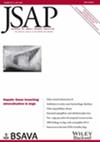Comparison of culture-dependent and -independent bacterial detection results on nasal swabs in dogs with nasal discharge
Abstract
Objectives
The role of bacterial communities in the pathophysiology of canine nasal disease is still unclear. How and when to treat dogs with suspected secondary bacterial rhinitis and on which test to rely before making a decision to treat with antimicrobials has not been established. The objective is to compare the results of bacterial identification using agar-plate cultures and 16S rRNA gene amplicon sequencing in dogs with nasal discharge suspected to be of bacterial origin.
Materials and Methods
Twenty-nine client-owned dogs presented for investigation of nasal disease were included in the study. Paired swabs were collected from the same affected nasal cavity. One swab was streaked on 4 agar media (Columbia Blood Agar, MacConkey, Chapman and Edward's). The other swab was stored in a sterile cryotube at −80°. Extracted DNA underwent a polymerase chain reaction targeting the V1-V3 region of the 16S rRNA gene.
Results
At least one of the species detected by amplicon sequencing with a relative abundance of >10% was also identified by culture in 14 cases (48.3%), in association with marked predominance of one taxon (>80% relative abundance) in six of 14 cases. In 12 dogs (41.4%), the cultured isolates were rare or undetected components of the corresponding sequence libraries. A negative culture in the face of bacterial predominance (>50% relative abundance) of a potentially pathogenic bacteria detected by sequencing occurred in 17% (n=5) of cases; however, the use of other agar media may have decreased this percentage.
Clinical Significance
Standard culture does not reliably predict the bacterial profile detected by 16S rRNA gene amplicon sequencing.

 求助内容:
求助内容: 应助结果提醒方式:
应助结果提醒方式:


